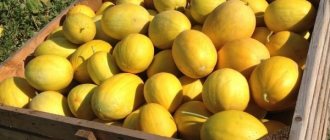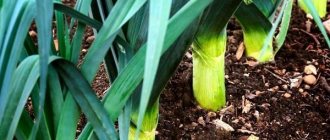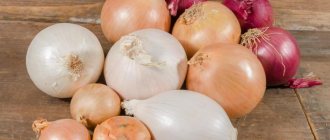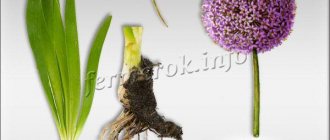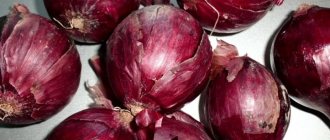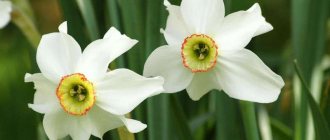Introduction
Among the wide variety of representatives of the onion family, onions rightfully occupy their rightful place. Why? It's simple. Mountains are considered the birthplace of onions. It was there that the first bulbs appeared, trying to survive in conditions of long winters and waterless summers.
In order not to perish, the onion had to accumulate nutrients in its leaves, called scales. A little later, everything began to be called an onion.
Thanks to man, the growing area has expanded significantly; many varieties of onions have been bred, differing in ripening time, color and taste of the pulp, size of the bulbs and agrotechnical cultivation methods, individually for each variety.
Varieties for long-term storage
Onions with golden-colored dry scales have the best shelf life . Such vegetables have a more bitter taste and a pungent odor, but they are stored almost until the new harvest due to the thickness and number of outer scales. Sweet varieties have few scales, they are too thin, so the keeping quality of the crop is low.
Important! According to reviews from summer residents, sweet colored varieties of onions (red, purple) quickly lose their presentation and taste.
How to store it correctly
Fully ripe dry specimens are selected for storage ; if necessary, they are dried several times.
The wintering room should be dry and cool (temperature - 0°C). Some species thrive at -3°C, and some at +18°C. It is not recommended to display baskets with harvest on the balcony: the vegetable cannot withstand temperature changes.
The harvest is kept in winter in “breathable” containers : boxes, baskets, mesh bags. Some housewives, following traditions, knit bulbs into wreaths and braid them.
Varieties of onions
When choosing onion varieties for growing in the country, you need to pay attention to the regional cultivation
Depending on the conditions and area of growth, varieties can be divided into 2 large groups:
- for northern regions
- for cultivation in the southern regions
Onion varieties intended for areas with cold climates have a pronounced pungent taste and excellent keeping quality. Onions grown in the southern regions have a sweeter taste, but do not last long. Southern - mainly salad types of onions.
White onions are also widely used. It has a sweetish, delicate taste. Also applies to salad types. Disadvantage: short shelf life and instability to diseases and pests.
Which variety is healthier for the body?
The benefits of onions for humans are enormous , but it cannot be said that red ones are healthier than white ones, or vice versa. It all depends on the health problems or prevention goals.
Any variety of crop has a powerful antimicrobial effect due to the presence of phytoncides. Vegetables of purple and red colors are more active in the fight against pathogenic microflora, since, in addition to phytoncides, they contain cyanidin.
If a person’s task is to stop the harmful activity of microorganisms, then white onions will be enough, but if you also need to strengthen the circulatory system, then a red or purple vegetable will help.
The plant has anthelmintic properties . White turnips are more effective in combating freckles and pigmentation.
To strengthen the immune system and replenish vitamins after winter, green onion varieties are suitable.
What are the differences between hot, semi-sharp and sweet onions?
Hot, semi-sharp and sweet varieties differ in taste, shelf life and bulb structure
Almost all early ripening varieties have a sharp taste. They have good keeping quality and a long shelf life. The bulbs contain a lot of nutrients: sugars, essential oils.
The only drawback is low yield. The heads of early varieties are wrapped in several layers of husk, so harvesting is possible not only manually, but also using specialized equipment. Can be grown in any region.
The semi-sharp varieties are sweeter with not very dense pulp and a small number of scales. It is not recommended to remove plantings with special equipment, as the bulbs are susceptible to injury and quickly deteriorate. The yield, compared to early varieties, is significantly higher. They can be cultivated in any region.
Sweet varieties are used to make salads. They are high-yielding, but have a short shelf life. Recommended for cultivation in the southern regions.
From the history of onions
The cultivation of onions occurred about 4 thousand years ago in Asia. In Russia, they learned about this vegetable crop in the middle of the 12th century; since then, almost no dish can do without onions. The vegetable has medicinal properties and is widely used in folk medicine.
All varieties, such as onions, differ in growth, appearance, taste, and ripening time. There are about 900 varieties of onions, but only 220 species are grown on land. The most common types of onions: turnip, batun, shallot, leek, slime, branched, multi-tiered, chives, fragrant.
Medium ripening
The growing season for these varieties ranges from 100 to 120 days. They are grown in different regions, mainly through planting sets. Varieties with an average ripening period are well stored, the bulbs can be transported over long distances, the heads are used for canning, eaten fresh and pickled.
Bessonovsky
Bessonovsky Currently, breeders are working to improve the characteristics of the variety, trying to return it to its former popularity.
- Small round or flattened bulbs, weighing up to 40 g
- Tightly fitting scales
- Spicy taste
- Long shelf life – up to 8 months
- Good presentation
- Average yield
- Not very resistant to diseases, susceptible to bottom rot and downy mildew.
- For preventive purposes, it is recommended to spray plantings with agents against pathogens of various diseases.
- A budget variety with good characteristics: good keeping quality, average yield and sharp taste of the pulp.
The variety is gradually degenerating, but gardeners are firmly convinced that the Bessonov variety does not lose popularity, because at low costs for purchasing seedlings, you can get a good harvest with good keeping quality of the bulbs, only it is recommended to buy planting material from trusted suppliers.
Hercules
Hercules
- Characterized by a long shelf life. During this time it does not lose its taste. It has a mild taste and onion aroma.
- Planting of seedlings is carried out after the ground has warmed up to +10 °C.
- Prefers fertile soil.
- It is recommended to add humus, peat, urea and superphosphate (1 tablespoon each) to the loams.
- If the soil is sandy, add peat, humus, 2 buckets of clay soil, superphosphate and urea (1 tbsp each).
Advantages:
- Productivity per 1 m2 – 8 kg
- Long shelf life without loss of taste
- Disease resistance
- A well-developed root system allows you to “survive” in dry times
- Spicy but pleasant taste.
Sturon
Sturon
- Dutch selection of medium ripening period. Around day 105, the bulbs reach technical ripeness. Suitable for growing in areas with both warm climates and temperate climates.
- Onion sets can be cultivated using annual and biennial cultivation methods. In the second year you can get large bulbs weighing up to 200 g.
- The bulbs are distinguished by their increased shelf life: they are stored all winter and do not lose their taste for 9 months. This feature increases the cost of the bulbs if its cultivation is used for commercial purposes.
- Depending on the fertility of the soil, up to 29 tons of crop can be obtained from 1 hectare. Grows well in sandy loam soils. Feedback from farmers indicates that onions are rarely affected by any insects, and therefore do not require frequent treatment with chemicals.
- They are grown not only in open ground, but also in greenhouse conditions to produce greens.
- During the growing season it is necessary to apply mineral and organic fertilizers. Once the bulbs reach a size of 2.5 cm, all feeding should be stopped. In the second year of cultivation, it is necessary to feed the plantings 2 times. Onions grow best on loamy and sandy soils.
Chalcedony
Chalcedony
- Belongs to breeders from Moldova. The white, juicy flesh of the oval or round bulbs has a pungent taste, but not acrid. The weight of one onion is up to 90 g.
- The variety is valued due to its high yield: from 1 m2 - up to 5 kg of onions. The harvest is harvested in August. The scales are bronze with a brown tint. Feature of the variety: during growth, the bulbs are located above the soil surface, which accelerates their ripening and facilitates harvesting.
- The bulbs of the variety are impressive in size, but the yield depends on climatic conditions and soil fertility.
- Chalcedony is rich in vitamins, contains folic acid, essential oils, and carotene.
Sweet varieties and hybrids
Spanish 313
The popular variety is famous for its mild sweet taste, which is characterized by a piquant slight pungency. The yellow bulbs are round, large, with white pulp of moderate density, weighing up to 200 g.
Ripens late, 130–140 days after emergence. The harvest is high, reaching 46 kg per 10 sq. m., well stored. Onions are disease-resistant and cold-resistant, which is rare among sweet varieties.
Yalta
Onion variety Yalta
The famous salad onion, suitable for fresh consumption, without bitterness or pungency, is very sweet. The harvest of this variety, traditionally grown by Crimean vegetable growers, can be obtained in the Middle Zone by planting through seedlings in 130–140 days.
The onion is flat-round, weighing about 150 g, deep purple in color with a crimson tint, the inner scales are thick, few in number, white with purple rings. It can only be stored braided and hung in a cool room, not for very long - up to 4-5 months.
Kutnowska
Salad onions, bred in Poland, are recommended for cultivation in the Central region. It is possible to sow seeds in open ground, and the vegetable shows itself to be mid-season - from germination to harvest it takes from 77 to 95 days.
The shape of the small onion is round, weight up to 90 g. The husk is brownish-golden, the flesh is creamy-white, juicy, very tasty, sweet, without pungency. The yield is moderate - 5–9 kg per 10 sq. m. Requires ripening after collection, safety is about 85%.
Caramel
The elongated small onions of this tasty salad variety grow about 10 cm long and weigh up to 60 g. The outer scales are an attractive purple color, the flesh is sweet with a slight pungency and a barely noticeable aroma. Caramel is early ripening and is recommended for growing through seedlings, for which the seeds are sown in March and planted in the ground in May. Harvesting in June-July.
Stored in a cool, ventilated area for several months. For good preservation and winter consumption, they are sown in April-May in open ground, harvesting in August-September.
Densimore
Sweet onions with good preservation and transportability are grown as an annual crop and are mid-season - harvested 115 days after germination. Aligned round onion heads with a thin neck have an attractive appearance and weigh 120–130 g.
The outer scales are golden with a bronze or greenish tint, the flesh is sweet and delicious. It is perfectly stored in ventilated areas, losses are insignificant, the husks do not fall off.
Winter onion varieties
There are varieties of onions that can and should be planted before winter. There is no need to be afraid, they are not susceptible to bolting and will not freeze over the winter. The only thing is that the sets should be planted late in the fall so that the feathers do not start to grow due to warm weather.
Radar
Radar
- It is a winter onion variety: it can be planted for the winter.
- Such planting will allow you to get a rich harvest. The variety is easy to care for and resistant to adverse weather conditions.
- Dark green foliage, round bulb with dense flesh.
- The weight of one bulb is up to 300 g. The golden-yellow scales are strong and dry.
- This feature increases the variety’s resistance to frost and storage.
- When sown before winter, the variety tolerates frosts from -15 °C (in the presence of little snow) to -23 °C (in the presence of snow).
Feature of the variety:
- The radar is not prone to bolting, is resistant to diseases and pests, and is easy to maintain.
- It takes 250 days from sowing to harvesting.
- It cannot be grown in the same place for more than 2 years.
Shakespeare
Shakespeare
- The Dutch winter variety Shakespeare is characterized by early ripening.
- The bulbs have a clear round shape, the bottom is yellow, the top is light brown.
- Not subject to shooting.
- The pulp is dense, juicy, the taste is semi-sharp.
- To reap a good harvest that will be stored for a long time, you need to plant the seedlings in a well-lit area without stagnant water.
- Fertilizer must be added to the soil in advance.
Resistance to frost is due to the structure of the onion: tightly fitting scales do not allow the onion to freeze even at sub-zero temperatures. In addition, after overwintering, the bulbs retain their presentation and taste.
Application and storage
Onions are used both raw in salads and in cooking. Greens are used as a seasoning in dried form, added to meat dishes, pies, and side dishes. It improves taste and saturates the body with vitamins and minerals.
Onions are often recommended by traditional medicine as a preventative against colds, exhaustion, and constant fatigue. In combination with aloe, radish, honey or dried apricots, onions are used to treat the upper and lower respiratory tract and fungal skin infections.
Detailed information about the benefits of green and onions can be found in our material.
To prevent the bulbs from losing their properties during wintering, they must be stored correctly. For these purposes, only ripe fruits without mechanical damage or putrefactive lesions are suitable.
In order not to lose the onion harvest, it is important to store it correctly
Before storing in a breathable container, the crop should be thoroughly dried. During the winter, you need to periodically sort through stocks, removing rotten bulbs. To prevent germination, you can burn the root lobes or cover them with lime paste.
You will find information about the rules for storing onions in our article.
Black onion: sowing, growing and care rules
Black onion does not belong to any special type or variety of onion. This is the general name for all onion seeds from which sets are grown.
Obtaining seeds
Growing nigella onions is a rather troublesome, but exciting task. To obtain full-fledged seeds, you need to sort the entire onion and select a pair of heads that correspond to the characteristic characteristics of the variety.
Obtaining seeds from your own planting material
Early spring is the best time to plant nigella onions. It should be planted immediately after the snow melts. Planting is practiced in late autumn, but it is recommended to cover the beds. Already in summer, the bulbs produce flower stalks: beautiful and fluffy umbrellas contain black seeds.
Sowing seeds for seedlings
Humus and wood ash are added to the prepared soil.
It is advisable to plant dill and calendula along with onion seeds. Marigolds repel nematodes, and dill sprigs repel onion flies. The pest is also afraid of carrots, so you can plant a carrot bed next to the onion bed.
Nigella onion seeds have a short shelf life. After a year, seed germination is reduced by half, so you need to plant fresh seeds and renew them every year.
Nigella seeds
Nigella can be sown immediately in moist soil; the seeds do not require preliminary disinfection. Regular watering is required until the first shoots appear above the surface.
Caring for young seedlings
If the seeds are sown densely, it is necessary to thin out and leave a distance of 2 cm between the seedlings. The second thinning is carried out after 20 days and is carried out if the nigella is grown to produce bulbs, if for sowing, one thinning is enough.
Babies are fed mullein diluted with water in a ratio of 1:5. During the growth period, you need to monitor the level of soil moisture daily; watering is stopped 3 weeks before harvesting the seeds.
Onion varieties that are suitable for growing through nigella:
- "Bessonovsky"
- "Belovezhsky"
- "Amber"
- "Strigunovsky"
- "Spassky"
Densimore
Densimore
- Small-nesting, attracts attention with good presentation and resistance to weather conditions and diseases.
- The pulp is juicy, white, semi-sharp in taste.
- Densimore develops well in fertile areas with sandy loam soil.
- Requires watering, but only during dry periods. Shallots also belong to the family.
- The difference between this species and ordinary onions lies in the size of the bulbs and their number in one nest.
Characteristics of the variety:
- Malognezdny
- Early ripening
- Round bulbs weigh up to 130 g
- Thin neck
- Yellow-bronze scales
- Good keeping quality
Shallot
Sample title
- Came to us from Normandy. It was opened in 1261. Distributed everywhere due to its taste.
- Unlike onions, shallots have smaller bulbs and strong branching. The bulbs are stored better.
- The early ripening variety is grown, firstly, for its vitamin and juicy greens, and secondly, for its numerous bulbs, the number of which can reach 30 pieces.
- Shallot varieties: Kuban yellow, Belozerets, Kunak.
Kuban yellow
Kuban yellow
- The universal variety was bred at the Krasnodar Research Institute in 1958. The feather is dark green in color with a clearly visible waxy coating. The width of the leaves reaches up to 1 cm, and the length of the leaf grows up to 21 cm. If you pull out the bulb along with the greens, their total weight will be 75-130 g.
- Thanks to its resistance to drought, the variety has gained universal popularity.
- The bulbs are round or round-flat, the flesh is juicy and semi-sharp. Up to 4 bulbs grow in one nest. The scales are yellow-brown.
- It is a medium-ripening variety; it takes approximately 85 days from sowing to harvesting.
- From 1 m2 you can harvest up to 3 kg of onions. It has good transportability and a long shelf life.
Belozerets
Belozerets
- The variety was also obtained at the Krasnodar Research Institute. The value of the variety is given by such a feature as the possibility of ripening after harvesting.
- The bulbs have a round oval or rounded shape, weight varies from 21 to 27 grams. The pulp is dense and juicy. Belongs to a small-growing variety.
- Dry scales are colored light lilac with a yellowish tint, the inner plates have a violet or lilac tint. The taste is spicy.
- Early, ripening occurs 80 days after planting. From 1 m2 they harvest up to one and a half kilograms of onions.
- Not susceptible to rust or downy mildew. Characterized by excellent keeping quality.
Types of green onions
Green onions are an excellent seasoning for salads, main and first courses. It contains calcium and phosphorus - elements that improve the condition of teeth, and zinc, which improves immunity and promotes the growth of hair and nails.
Green onions contain virtually no calories. In average climatic zones, gardeners grow the following types of onions for greens.
Green onion Batun
It does not produce bulbs; the fistula leaves are used for food. Medium spiciness, pronounced aroma. Batun is added to salads and used for cooking. It is not added to canned food, only to quick marinades.
Batun is the most common type of green onion
Sowing is recommended on loosened soil in mid-May. The variety produces the greatest yield in the second year of life.
Schnitt
Reproduction is carried out by seeds and dividing the bush. The plant is edible, but is considered ornamental and is used in flower beds. It is not used in canned food or hot dishes, as it has a mildly spicy taste. The leaves reach commercial quality by September in the second year.
Chives - a decorative flowering type of green onion
Green onion variety Slizun
A fragrant plant with a high content of iron and vitamins. Mainly used for preparing fresh salads.
Slizun onions are grown to produce early greens in March
The crop is propagated by dividing bushes, seeds and seedlings. Leaves grow in early spring.
Multi-tiered green onion
It reproduces exclusively by vegetative means, grows quickly, and does not enter a dormant state. In the spring, root bulbs are planted, and in the fall, aerial bulbs. Planting requires homogeneous, loose, fertile soil.
Multi-tiered onions are propagated by bulbs and by dividing the bulb
The bases of the tubular leaves are used for food, and the bulbs (aerial seed pods) are pickled in brine. Greens are used in salads and canning.
Leek
A biennial crop containing essential oils in the leaves. The stem is suitable for eating raw, boiled, or stewed.
Green onions Leek is a very aromatic and healthy vegetable that is prepared as a main dish.
For temperate climates, the Karantan variety, which is grown by seedlings, is most suitable. Young plants are transferred to open ground in early May, watered abundantly in summer and periodically hilled. Partial harvesting is allowed at the 4-5 leaf stage and can continue until late autumn.
Shallot Pervomaisky
This variety is a bulb variety, but it is grown for greens, since its bulb is small and does not have a pronounced taste. The crop is quite cold-resistant, so it is planted in the first ten days of spring, after the snow melts. Before planting, the soil is well fertilized.
Shallots are one of the earliest ripening types of green onions.
It is used fresh and for preparing various dishes. Used for quick marinades.
Green onion variety Angular
Perennial species with fragrant inflorescences. It is distinguished by the active growth of new buds and produces juicy greens in late autumn.
Angular green onions are both an ornamental and edible plant.
Green onions oblique
In appearance, taste and aroma it resembles garlic, and can replace it when preserving vegetables. This is a perennial crop, but it is recommended to grow it for no more than 3 years in one place.
Green onions Oblique are often grown instead of garlic
Aging onion (puchu)
Aging onion or puchu is a wild odorous plant widely distributed in the South-East of Eurasia, Siberia, the Far East, and the Altai Territory. In Korea, it is specially grown as an agricultural crop, an improved variety, more delicate in taste. Juicy leaf feathers are edible only in spring; as they grow, they become coarser and become bitter, which is why it is called aging onion.
Aging onion, puchu
There are 4 types of puchu:
- The European species is distinguished by long, straight feathers.
- Transbaikalian grows as a powerful bush and with short leaves.
- The Altai-Sayan species has short, straight leaves.
- The Far Eastern species is distinguished by long, spiral-shaped leaves.
By the end of summer, onions acquire a specific prickly taste; in this form they are crushed and dried. Cooks bake these onions, fry them, prepare them as a seasoning, ferment them, salt them, but they still give preference to green onions.
What are the different types of onions?
Classification of onion types is carried out based on various characteristics of the vegetable. According to the ripening period, varieties are distinguished:
- Early - the fetus develops in 90-110 days. Famous varieties are Red Baron, Karatalsky, Carmen.
- Mid-season - fruit formation occurs in 105-120 days. Shakespeare, Globus, Chalcedony, and Russian Winter are recognized as the best varieties of onions of this type.
- Late - the growing season lasts 120-145 days. These include the varieties Kaba, Dzhusay, Globo.
Based on their taste characteristics, vegetables are distinguished:
- Acute - this group includes early-ripening species. They have a long shelf life.
- Peninsular - includes mid-season species, the yield is higher than that of the previous type.
- Sweet - due to the lower concentration of essential oils, there is no bitterness and overly pungent shades in taste.
The most popular onion is the onion. It is planted everywhere and is used in cooking and alternative healing.
The best fertile varieties of onions include:
- Aleko;
- Golden;
- Carmen;
- Sturon;
- Timiryazevsky;
- Orion.
The volume of the harvest and its characteristics depend on the planting raw materials. The best varieties of onion sets include:
- Sturon;
- Stuttgarter Riesen;
- Hercules;
- Red Baron;
- Stardust.
This planting material is characterized by unpretentiousness and fertility.
Suvorov's bow (anzur, aflatun, giant)
Anzur onion is a perennial herbaceous plant that grows in mountainous regions of Europe and Asia. Has several types:
- Suvorov's bow - named after the Russian commander. Legend says that on his orders, this particular bow was used in the Russian army, which saved many soldiers from scurvy and other diseases.
- Giant.
- Aflatunsky.
- Mountain bow.
The vegetable crop has long, wide leaves, a thin, hard arrow, grows up to 150 cm, crowned with a large, bright purple inflorescence. The varieties of this onion differ only in the size of the bulbs and leaves.
Giant Mountain Bow
Only young leaves are suitable for eating; after a few weeks they turn yellow and become rough. The bulbs themselves are not consumed raw because of their specific smell. But when prepared in different ways, they become a valuable source of useful elements. For example, it contains 4-5 times more vitamin C than all other types of onion vegetables. Azure is called the brother of ginseng for its rich vitamin and mineral composition.
Anzura bulb
Traditional medicine treats such ailments as:
- hypertension;
- skin diseases;
- rheumatism;
- colds, bronchitis;
Regular consumption improves vision. Excess of the product can cause allergies and even (God forbid) poisoning. Landscape designers love anzur for its bright appearance and are happy to use it as decoration in gardens and parks.
Beautiful and useful onion-anzur
Carmen
Red onion, which is very popular among summer residents. They brought him out in Holland. The density of the fruits is moderate, they are round-flat in shape and weigh no more than 70 grams. Carmen onion sets quickly adapt to environmental conditions and respond adequately to temperature changes, droughts and rains. So you can grow it in the northern regions.
Sets suitable for planting must be dense and whole, and free from any damage or suspicious odors. It is very important to inspect them for rot. You should not plant specimens with a diameter of more than 1.5 centimeters - they are prone to bolting.
Carmen is not a very demanding variety, for a good harvest you need to water it often (the specific schedule depends on weather conditions, usually activities are carried out 1-2 times every 2 weeks), fertilize (three times during the entire growing season) and monitor environmental conditions, to respond to them in a timely manner.
During the growing season, feathers can be trimmed and added to various dishes. If they are not needed, they are removed before harvesting.
The variety is afraid of such parasites as onion muskellunge, onion fly and moth, nematode, and root mite. It is very important to treat onions to prevent them from appearing. In addition, you need to protect the plant from fungi.
The yield with proper care is not bad - 2.5 kilograms per 1 m2. Under the right conditions, store the fruits for 8 months.
Onion (Tatarka, sandy, tubular, winter, pipe)
Batun is a popular variety of perennial onion, a vegetable crop of the onion family, grown from seeds. It has different names: sandy, Tatarka, winter (for its excellent winter hardiness), and received the nickname fistula for its powerful tubular leaves. On the territory of the Russian Federation it grows wild in Siberia and the Far East. As a spicy vegetable, it is cultivated on all continents except Antarctica.
Batun is grown on all continents except Antarctica
Tatarka, also known as batun, is divided into three types:
- Russian - with small, green feathers, spicy in taste.
- Chinese - has wide, juicy stems with a spicy taste.
- Japanese - thin leaves with a delicate, semi-sharp taste.
The batun is radically different from the onion one; it is grown for its green feathers. It has a well-developed root system and reaches a height of up to 70 cm.
Tube-leaves form throughout the summer, and its green shoots appear in early spring. The leaves gradually die off, and a thickened stem (false bulb) forms. In the second year of life, onions appear flowers in the shape of a spherical umbrella. Onion has a sharp, bright taste. Rich in sugar, protein, vitamins C, B, PP, various micro- and macroelements, phytoncides.
Onion
In cooking, the entire stem or only the green part is used as a seasoning for first and second courses. Pies with egg and onion, mmm...
This type of onion has healing properties, like onions: improves digestion, increases immunity, normalizes metabolism, and fights worms. It should be remembered that people suffering from various gastrointestinal diseases should limit their consumption of batun.
Shallots (family, kushchevka, magpie)
In appearance, shallots are similar to onions, but shallots are round, and shallots have a head divided into slices, which is why they are called family or magpie . It ripens faster than onion and has a long, juicy feather. Asia and the Middle East are considered to be their homeland; now this is a very popular variety of onion, cultivated almost everywhere. The bush is grown by seeds or heads. In the first year of planting, it is used for greenery; after wintering, a large onion is obtained, divided into lobes.
Shallot
The magpie is considered a dietary vegetable; the calorie content of the bulbs is only 70 kcal, and that of a green bunch is 18-20 kcal. But there are a lot of vitamins: PP, carotene, group of B vitamins in full. Mineral composition: iron, magnesium, calcium, potassium, sulfur, zinc, etc. Cooks use greens and heads for a wide variety of dishes. It has a delicate, sweet, tangy taste. Shallots are very popular in French cuisine and are used as the basis for the famous French onion soup.
